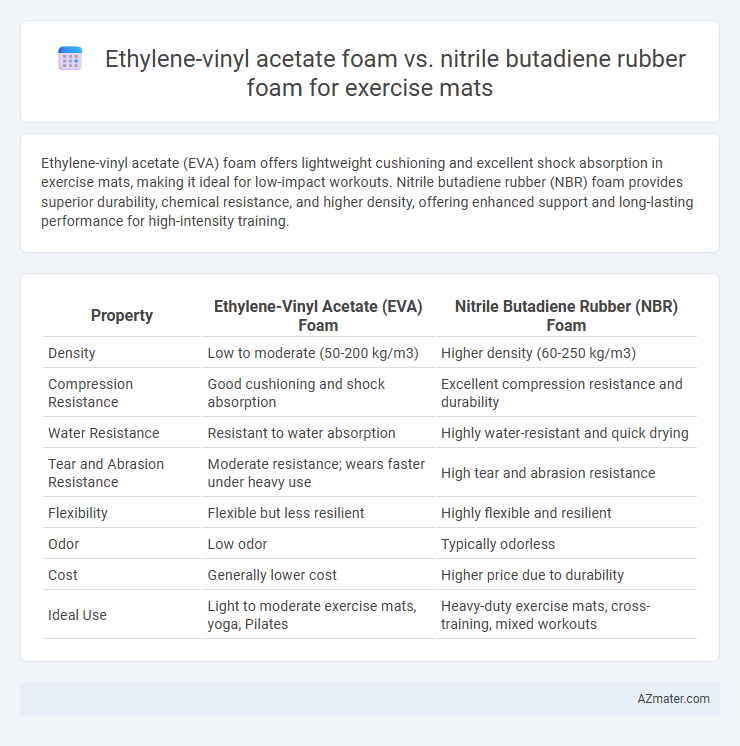Ethylene-vinyl acetate (EVA) foam offers lightweight cushioning and excellent shock absorption in exercise mats, making it ideal for low-impact workouts. Nitrile butadiene rubber (NBR) foam provides superior durability, chemical resistance, and higher density, offering enhanced support and long-lasting performance for high-intensity training.
Table of Comparison
| Property | Ethylene-Vinyl Acetate (EVA) Foam | Nitrile Butadiene Rubber (NBR) Foam |
|---|---|---|
| Density | Low to moderate (50-200 kg/m3) | Higher density (60-250 kg/m3) |
| Compression Resistance | Good cushioning and shock absorption | Excellent compression resistance and durability |
| Water Resistance | Resistant to water absorption | Highly water-resistant and quick drying |
| Tear and Abrasion Resistance | Moderate resistance; wears faster under heavy use | High tear and abrasion resistance |
| Flexibility | Flexible but less resilient | Highly flexible and resilient |
| Odor | Low odor | Typically odorless |
| Cost | Generally lower cost | Higher price due to durability |
| Ideal Use | Light to moderate exercise mats, yoga, Pilates | Heavy-duty exercise mats, cross-training, mixed workouts |
Introduction to Exercise Mat Materials
Ethylene-vinyl acetate (EVA) foam and Nitrile butadiene rubber (NBR) foam are two popular materials used in exercise mats, each offering distinct advantages. EVA foam provides lightweight, flexible cushioning with excellent shock absorption, making it ideal for yoga and pilates mats, while NBR foam delivers superior durability, resistance to oil and sweat, and higher density for better support during intense workouts. Selecting between EVA and NBR foam depends on factors such as exercise type, desired comfort, and mat longevity requirements.
Overview of Ethylene-Vinyl Acetate (EVA) Foam
Ethylene-vinyl acetate (EVA) foam offers excellent cushioning, shock absorption, and flexibility, making it a popular choice for exercise mats. Its closed-cell structure provides superior water and UV resistance, enhancing durability during intense workouts and outdoor use. Compared to nitrile butadiene rubber (NBR) foam, EVA is lighter and provides a softer, more comfortable surface for yoga, pilates, and general fitness routines.
Overview of Nitrile Butadiene Rubber (NBR) Foam
Nitrile Butadiene Rubber (NBR) foam offers exceptional resistance to oils, chemicals, and abrasion, making it a durable choice for exercise mats. Its closed-cell structure provides excellent cushioning and shock absorption, enhancing comfort during high-impact workouts. Compared to Ethylene-vinyl acetate (EVA) foam, NBR foam excels in durability and moisture resistance, ensuring long-lasting performance and hygiene.
Cushioning and Comfort: EVA vs NBR
Ethylene-vinyl acetate (EVA) foam offers superior cushioning with its lightweight, flexible, and shock-absorbing properties, making it ideal for exercise mats that require both comfort and impact protection. Nitrile butadiene rubber (NBR) foam provides excellent density and resilience, delivering firm support and durability but with slightly less softness compared to EVA. EVA foam tends to maintain comfort over extended use due to its better moldability and breathability, while NBR foam excels in resistance to compression and moisture absorption, affecting long-term cushioning performance.
Durability and Longevity Comparison
Ethylene-vinyl acetate (EVA) foam offers superior durability with high resilience against compression and cracking, making it ideal for long-term use in exercise mats. Nitrile butadiene rubber (NBR) foam provides excellent resistance to wear and tear but may degrade faster under prolonged exposure to UV light and sweat. Overall, EVA foam outperforms NBR in longevity due to its enhanced resistance to environmental stressors and sustained cushioning properties.
Water and Sweat Resistance Properties
Ethylene-vinyl acetate (EVA) foam exhibits superior water resistance compared to nitrile butadiene rubber (NBR) foam, making it less prone to water absorption and quicker to dry, which enhances hygiene during intense workouts. NBR foam offers moderate sweat resistance but tends to retain moisture longer, potentially leading to odor retention and decreased durability over time. For exercise mats, EVA's hydrophobic properties and ease of cleaning provide a distinct advantage in maintaining a dry, odor-free surface during prolonged use.
Environmental Impact and Sustainability
Ethylene-vinyl acetate (EVA) foam, commonly used in exercise mats, is derived from petroleum but offers good recyclability and lower volatile organic compound (VOC) emissions compared to nitrile butadiene rubber (NBR) foam, which is also petroleum-based but less biodegradable and more challenging to recycle. EVA foam's production generally results in a smaller carbon footprint due to more energy-efficient manufacturing processes, while NBR foam involves more intensive chemical treatments that contribute to environmental pollution. Choosing EVA foam supports greater sustainability in exercise mats by combining performance with improved end-of-life recyclability and reduced ecological impact.
Cost and Affordability Analysis
Ethylene-vinyl acetate (EVA) foam exercise mats generally present a more cost-effective option compared to nitrile butadiene rubber (NBR) foam, making them widely preferred for budget-conscious consumers. EVA foam offers affordability with durable cushioning and is mass-produced, which lowers manufacturing expenses, while NBR foam, known for superior resilience and chemical resistance, commands a higher price point due to its specialized material properties. Consumers seeking a balance between cost and performance often choose EVA foam mats, whereas NBR mats are favored in settings prioritizing durability and premium comfort despite the increased investment.
User Experience and Performance Review
Ethylene-vinyl acetate (EVA) foam provides a lightweight, cushioned surface with excellent shock absorption and moisture resistance, enhancing comfort during high-impact workouts. Nitrile butadiene rubber (NBR) foam offers superior durability and resilience, maintaining firmness and shape over extended use, which benefits users requiring stable support for yoga or Pilates. Performance reviews highlight EVA mats as ideal for portability and breathability, while NBR mats excel in tear resistance and providing a non-slip grip on various floor surfaces.
Conclusion: Choosing the Best Foam for Exercise Mats
Ethylene-vinyl acetate (EVA) foam offers excellent cushioning, lightweight properties, and superior shock absorption, making it ideal for high-impact workouts and yoga mats. Nitrile butadiene rubber (NBR) foam provides better durability, higher resistance to oils and chemicals, and greater resilience under prolonged use, fitting well for heavy-duty exercise environments. Selecting the best foam depends on prioritizing either comfort and flexibility with EVA or durability and chemical resistance with NBR for exercise mats.

Infographic: Ethylene-vinyl acetate foam vs Nitrile butadiene rubber foam for Exercise Mat
 azmater.com
azmater.com